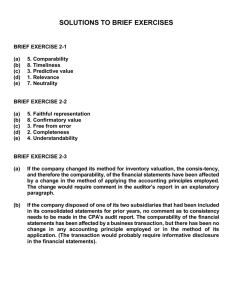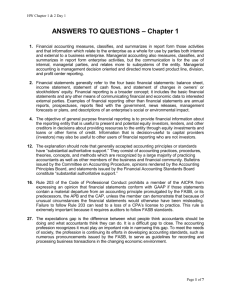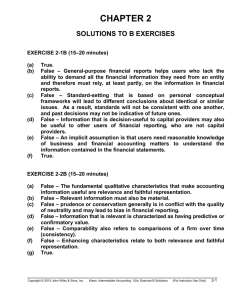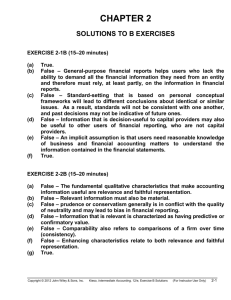Document
advertisement
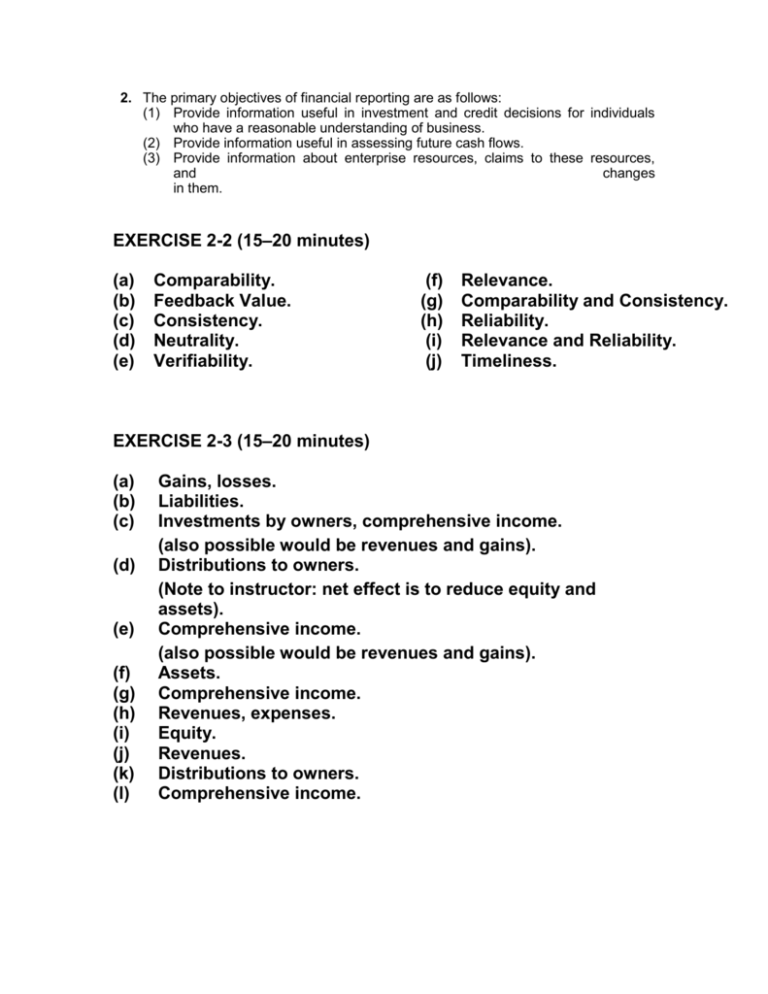
2. The primary objectives of financial reporting are as follows: (1) Provide information useful in investment and credit decisions for individuals who have a reasonable understanding of business. (2) Provide information useful in assessing future cash flows. (3) Provide information about enterprise resources, claims to these resources, and changes in them. EXERCISE 2-2 (15–20 minutes) (a) (b) (c) (d) (e) Comparability. Feedback Value. Consistency. Neutrality. Verifiability. (f) (g) (h) (i) (j) Relevance. Comparability and Consistency. Reliability. Relevance and Reliability. Timeliness. EXERCISE 2-3 (15–20 minutes) (a) (b) (c) (d) (e) (f) (g) (h) (i) (j) (k) (l) Gains, losses. Liabilities. Investments by owners, comprehensive income. (also possible would be revenues and gains). Distributions to owners. (Note to instructor: net effect is to reduce equity and assets). Comprehensive income. (also possible would be revenues and gains). Assets. Comprehensive income. Revenues, expenses. Equity. Revenues. Distributions to owners. Comprehensive income. EXERCISE 2-4 (15–20 minutes) (a) (b) (c) (d) (e) (f) (g) (h) (i) (j) 7. 5. 8. 2. 12. 1. 4. 11. 10. 3. Expense recognition principle. Historical cost principle. Full disclosure principle. Going concern assumption. Conservatism. Economic entity assumption. Periodicity assumption. Industry practices. Materiality. Monetary unit assumption. EXERCISE 2-7 (a) This entry violates the economic entity assumption. This assumption in accounting indicates that economic activity can be identified with a particular unit of accountability. In this situation, the company erred by charging this cost to the wrong economic entity. (b) The historical cost principle indicates that assets and liabilities are accounted for on the basis of cost. If we were to select sales value, for example, we would have an extremely difficult time in attempting to establish a sales value for a given item without selling it. It should further be noted that the revenue recognition principle provides the answer to when revenue should be recognized. Revenue should be recognized when (1) realized or realizable and (2) earned. In this situation, an earnings process has definitely not taken place. (c) Probably the company is too conservative in its accounting for this transaction. The matching principle indicates that expenses should be allocated to the appropriate periods involved. In this case, there appears to be a high uncertainty that the company will have to pay. FASB Statement No. 5 requires that a loss should be accrued only (1) when it is probable that the company would lose the suit and (2) the amount of the loss can be reasonably estimated. (Note to instructor: The student will probably be unfamiliar with FASB Statement No. 5. The purpose of this question is to develop some decision framework when the probability of a future event must be assumed.) EXERCISE 2-7 (Continued) (d) At the present time, accountants do not recognize pricelevel adjust-ments in the accounts. Hence, it is misleading to deviate from the cost principle because conjecture or opinion can take place. It should also be noted that depreciation is not so much a matter of valuation as it is a means of cost allocation. Assets are not depreciated on the basis of a decline in their fair market value, but are depreciated on the basis of systematic charges of expired costs against revenues. (Note to instructor: It might be called to the students’ attention that the FASB does encourage supplemental disclosure of price-level information.) (e) Most accounting methods are based on the assumption that the busi-ness enterprise will have a long life. Acceptance of this assumption provides credibility to the historical cost principle, which would be of limited usefulness if liquidation were assumed. Only if we assume some permanence to the enterprise is the use of depreciation and amortization policies justifiable and appropriate. Therefore, it is incorrect to assume liquidation as Gonzales, Inc. has done in this situation. It should be noted that only where liquidation appears imminent is the going concern assumption inapplicable. (f) The answer to this situation is the same as (b).


